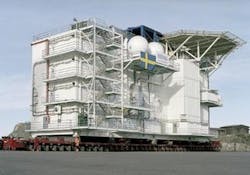Accommodation Modules - Major operators accepting benefits of standardized living quarters
Nick Terdre
Contributing Editor
Standardization of offshore accommodation units could provide significant savings for owners, as well as speeding up the delivery schedule. This new approach is being promoted by Pharmadule Emtunga, which has worked with major operators around the world during its 30 years as an offshore module fabricator.
According to marketing director Klas Wallin, the advantages of standardization are evident in the three virtually identical living quarters that the company is supplying to AIOC/BP for the Chirag Full Field Phase 2 development offshore Azerbaijan. These units each have 198 beds, and each weighs 1,150 tonnes. Because of transport restrictions along Russia's river and canal network between the Baltic and Caspian Seas, each unit is being delivered in 44 modules that are then assembled at the SPS shipyard in Baku. Delivery of the quarters for the Central Azeri PDQ platform was completed late last year, and assembly was completed this March.
In May the first modules for the West Azeri platform were shipped from Pharmadule Emtunga's Arendal yard in Gothenburg, Sweden, and this living quarters unit should be ready for load-out next spring. Fabrication of the quarters for East Azeri began earlier this year and should be fully assembled by spring 2006.
Pharmadule Emtunga's investigations indicate that series production based on the same design creates cost savings of around 10% for the second unit in the series and somewhat more for the third, Wallin says. Savings accrue partly from reduced design costs, which normally account for about 10% of the overall production cost. Another major source of savings lies in procurement, where better prices can be achieved from suppliers because of the larger quantities ordered. Time can also be saved in the production of the second and subsequent units, which may imply economic benefits for the development project, although provision of the accommodation facilities is not normally critical to a project schedule.
When it comes to the footprint of living quarters, there are two main design approaches, Wallin says. The first is a rectangular structure with a single central corridor and rooms on either side, while the second is a square building with either a circular corridor or two corridors in parallel. The company's own preference is for a rectangular design, which it finds easier to construct in modular form and for which it can therefore offer better prices.
The company has already floated its idea with AIOC/BP in Azerbaijan who were thinking on the same lines, according to Wallin. Later this year, it intends to take it to the market in general. It has also discussed its proposal with a number of fabrication yards in the Far East, which could lead to a fruitful cooperation.
Kristin record delivery
In February, Pharmadule Emtunga delivered the largest living quarters it has ever built. The unit, which is for Statoil's Kristin platform, weighs 2,100 tonnes and contains 108 beds in single cabins. The company has supplied quarters previously to Statoil, i.e. for Åsgaard B in 2000. Pharmadule Emtunga also provided assistance with commissioning of the Kristin unit at the Aker Stord yard in western Norway and was due to make the final handover in mid June.
A week later, the completed accommodation unit for BP's Mad Dog development in the Gulf of Mexico left Pharmadule Emtunga's Arendal yard. Weighing 1,220 tonnes, the module accommodates 130 personnel in a mixture of two- and four-bed cabins. This was the first project in which the company worked to US Coast Guard requirements, says Wallin. It is an all-steel structure, including the helideck, as the US Coast Guard has not approved the use of aluminum, even for helidecks. It was also the company's first delivery to a spar platform. The order, worth around SEK135 million to Pharmadule Em-tunga, was delivered on schedule and within budget.
Recently, the company was awar-ded an SEK50-million contract by Consafe Offshore in connection with the conversion of Sedco 602, a semisubmersible drilling rig, into an accommodation rig under the name Safe Astoria. It will supply 36 type 5 modules, most containing two four-bed cabins, but some fitted out as storerooms. These will be sent to a shipyard in Singapore by November. Total weight of the delivery is 430 tonnes. A similar contract is expected to be tendered by Consafe at a future date for a second rig that it has acquired for conversion purposes.
null
Mexican possibilities
Pharmadule Emtunga is also prequalified to bid for work in the Mexican offshore sector, which Pemex was expected to tender last month. Pemex plans to install up to six accommodation platforms, although these are likely to be awarded in three contracts, each covering two platforms. The module builders are required to team up with a jacket fabricator – in Pharmadule Emtunga's case, this is the Dragados yard in Mexico. The platforms, which will provide accommodation for 200 people in four-bed cabins, are due for delivery in 2006. There is scope for standardization also in this project, following discussions with Pemex, Wallin says.
The company is also hopeful of securing more work for Eni's Kashagan project in Kazakhstan's sector of the Caspian. The operator has tendered for a number of 120-man turnkey accommodation barges, similar to two such units that Pharmadule Emtunga supplied to it last year. It has also established a strong position in the Caspian, supplying seven out of eight accommodation facilities awarded there in the post Soviet Union era, Wallin says.
For more information, contact Klas Wallin, Pharmadule Emtunga. Tel +46 512 770 400, fax +46 512 129 62, [email protected], www.emtunga.com

